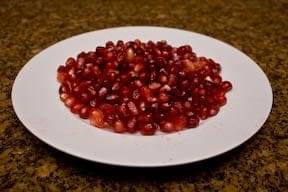We learned how to make Kimchi from our friends Mum. She makes the best authentic Kimchi. It’s always a little different and always absolutely delishious. Our friend’s pretty talented with pickles, Kimchi, and similar ferments, too. She’s the one I call when I’m out of an ingredient and need to find a fix…or I’ve just gone Vegan and need to figure out how to adjust my Traditional Kimchi recipe to exclude the fish sauce but still capture that ocean flavor that rides under the surface of the really good stuff.
This recipe eliminates the two ingredients in Traditional Kimchi that are most inflammatory – the sugar and the fish sauce. Part of our reason for going Vegan was to reduce inflammation, thus the adjustment. Part of it was to take better care of our digestive systems through a daily dose of Fermented Foods. What better way to accomplish both than to keep a crock of Kimchi on the counter and dip in for each meal?
I recommend using a high-mineral, unrefined or natural salt if possible. Avoid iodized table salt because it can inhibit fermentation. Kosher salt is a reasonable choice if unrefined salt isn’t available to you.
Ingredients
- 2 pounds (907 g) Napa Cabbage
- 1 pound (450g) other vegetables, such as Daikon Radish, and Carrot
- 1-2 large Apples
- 5 inches (13 cm) or so fresh Ginger root
- 1 head Garlic or so
- 1-2 handfuls Wakame or similar dried seaweed
- 2-3 Tbsp (15 ml) high-mineral Salt or similar
- 1-3 large handfuls Korean Red Pepper Flakes (Korean Hot Pepper Powder)
Equipment
- Cutting board
- Knife
- Scale
- Large bowl
- Spoon for stirring
- Canning Funnel
- Half-gallon canning jar with plastic lid or similar
How-to
- Set the large bowl on your scale and Tare it so that you can easily read the weight as you work.
- Quarter the Napa Cabbage and chop it into chunks roughly three fingers wide, so fat rectangles or squares. Add them to the large bowl. Aim for about 2 pounds or 907 g of Napa Cabbage total.
- Quarter and chop the Daikon Radish into large bite-sized chunks and add them to the bowl. Aim for about a quarter to a half pound or 113-226 g.
- Roughly chop the Carrot into small bite-sized chunks and add them to the bowl. Aim for roughly a half pound (226 g).
- Cut the Apple into small pieces and add it to the bowl. You should now have approximately 3 lbs or 1360 g of vegetables. If not, add more Radish, Napa Cabbage (or green cabbage), or Carrot to make the desired total.
- Remove the bowl from the scale and set the scale aside.
- Peel and finely chop the ginger root then add it to the bowl.
- Peel and roughly chop the garlic then add it to the bowl.
- Add the Wakame or seaweed to the bowl.
- Mix the vegetables well.
- Sprinkle the salt on the vegetables, mix them well, then squeeze them.
- Set the bowl aside for awhile so the juices can start to come out of the vegetables. It varies how long this will take, maybe under an hour or maybe a few hours. Now is a terrific time to catch up on your Real Herbalism Radio podcasts. It’s okay if they sit a little longer, so maybe even listen to several podcasts while they rest.
- Once the juices have begun to run, set up your canning jar and funel close to your bowl.
- Add the Korean Red Pepper Flakes to the vegetables and mix them well. You’ll want to do this part with your clean hands.
- Once your vegetables and Korean Red Pepper Flakes are well mixed, pack them into the canning jar. Press them down so that the juices rise up to cover the solid bits. If you don’t quite have enough juice to cover the vegetables, that’s okay. You can press it down again in a few hours and then again the next day. By then, you’ll probably have enough juice to cover the vegetables. If not, you can add a small amount of brine made with a ratio of roughly 1 Tbsp (15 g) salt to 8 oz (236 ml) water.
- Cover the mixture loosely and set it on a protected surface, such as in a bowl or plate. As fermentation begins, you may have juices that overflow if you haven’t left enough room at the top of the jar.
Storage and Use
Kimchi generally begins to ferment quickly. Mine is often ready to eat within two or three days in the winter, sooner in the summer. After a couple of days, give it a try. If it tastes salty and not sour, let it stand longer. When it starts to have a tang or sour flavor, it’s time to start eating it. It’ll continue to change in flavor as it sits on the counter. You can put it in the refridgerator to slow the fermentation, if you so desire. If it stands long, it can become quite sour. If you hit that point, consider adding it to tossed salads and similar larger dishes to disperse the intensity of the sour.






